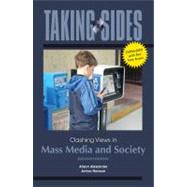
Table of Contents Clashing Views in Mass Media and Society, Eleventh Edition, Expanded Unit 1 Media and Social Issues
Unit 2 A Question of Content
Unit 3 News and Politics
Unit 4 Law and Policy
Unit 5 Media Business
Unit 6 Life in the Digital Age
|
The New copy of this book will include any supplemental materials advertised. Please check the title of the book to determine if it should include any access cards, study guides, lab manuals, CDs, etc.
The Used, Rental and eBook copies of this book are not guaranteed to include any supplemental materials. Typically, only the book itself is included. This is true even if the title states it includes any access cards, study guides, lab manuals, CDs, etc.